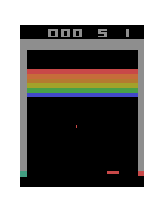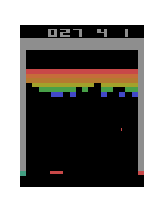Deep Q-Learning for Atari Breakout
Author: Jacob Chapman and Mathias Lechner
Date created: 2020/05/23
Last modified: 2024/03/16
Description: Play Atari Breakout with a Deep Q-Network.
Introduction
This script shows an implementation of Deep Q-Learning on the
BreakoutNoFrameskip-v4 environment.
Deep Q-Learning
As an agent takes actions and moves through an environment, it learns to map the observed state of the environment to an action. An agent will choose an action in a given state based on a "Q-value", which is a weighted reward based on the expected highest long-term reward. A Q-Learning Agent learns to perform its task such that the recommended action maximizes the potential future rewards. This method is considered an "Off-Policy" method, meaning its Q values are updated assuming that the best action was chosen, even if the best action was not chosen.
Atari Breakout
In this environment, a board moves along the bottom of the screen returning a ball that will destroy blocks at the top of the screen. The aim of the game is to remove all blocks and breakout of the level. The agent must learn to control the board by moving left and right, returning the ball and removing all the blocks without the ball passing the board.
Note
The Deepmind paper trained for "a total of 50 million frames (that is, around 38 days of game experience in total)". However this script will give good results at around 10 million frames which are processed in less than 24 hours on a modern machine.
You can control the number of episodes by setting the max_episodes variable
to a value greater than 0.
References
Setup
import os
os.environ["KERAS_BACKEND"] = "tensorflow"
import keras
from keras import layers
import gymnasium as gym
from gymnasium.wrappers import AtariPreprocessing, FrameStack
import numpy as np
import tensorflow as tf
# Configuration parameters for the whole setup
seed = 42
gamma = 0.99 # Discount factor for past rewards
epsilon = 1.0 # Epsilon greedy parameter
epsilon_min = 0.1 # Minimum epsilon greedy parameter
epsilon_max = 1.0 # Maximum epsilon greedy parameter
epsilon_interval = (
epsilon_max - epsilon_min
) # Rate at which to reduce chance of random action being taken
batch_size = 32 # Size of batch taken from replay buffer
max_steps_per_episode = 10000
max_episodes = 10 # Limit training episodes, will run until solved if smaller than 1
# Use the Atari environment
# Specify the `render_mode` parameter to show the attempts of the agent in a pop up window.
env = gym.make("BreakoutNoFrameskip-v4") # , render_mode="human")
# Environment preprocessing
env = AtariPreprocessing(env)
# Stack four frames
env = FrameStack(env, 4)
env.seed(seed)
A.L.E: Arcade Learning Environment (version 0.8.1+unknown)
[Powered by Stella]
Game console created:
ROM file: /Users/luca/mambaforge/envs/keras-io/lib/python3.9/site-packages/AutoROM/roms/breakout.bin
Cart Name: Breakout - Breakaway IV (1978) (Atari)
Cart MD5: f34f08e5eb96e500e851a80be3277a56
Display Format: AUTO-DETECT ==> NTSC
ROM Size: 2048
Bankswitch Type: AUTO-DETECT ==> 2K
Running ROM file...
Random seed is -975249067
Game console created:
ROM file: /Users/luca/mambaforge/envs/keras-io/lib/python3.9/site-packages/AutoROM/roms/breakout.bin
Cart Name: Breakout - Breakaway IV (1978) (Atari)
Cart MD5: f34f08e5eb96e500e851a80be3277a56
Display Format: AUTO-DETECT ==> NTSC
ROM Size: 2048
Bankswitch Type: AUTO-DETECT ==> 2K
Running ROM file...
Random seed is -1625411987
(3444837047, 2669555309)
Implement the Deep Q-Network
This network learns an approximation of the Q-table, which is a mapping between the states and actions that an agent will take. For every state we'll have four actions, that can be taken. The environment provides the state, and the action is chosen by selecting the larger of the four Q-values predicted in the output layer.
num_actions = 4
def create_q_model():
# Network defined by the Deepmind paper
return keras.Sequential(
[
layers.Lambda(
lambda tensor: keras.ops.transpose(tensor, [0, 2, 3, 1]),
output_shape=(84, 84, 4),
input_shape=(4, 84, 84),
),
# Convolutions on the frames on the screen
layers.Conv2D(32, 8, strides=4, activation="relu", input_shape=(4, 84, 84)),
layers.Conv2D(64, 4, strides=2, activation="relu"),
layers.Conv2D(64, 3, strides=1, activation="relu"),
layers.Flatten(),
layers.Dense(512, activation="relu"),
layers.Dense(num_actions, activation="linear"),
]
)
# The first model makes the predictions for Q-values which are used to
# make a action.
model = create_q_model()
# Build a target model for the prediction of future rewards.
# The weights of a target model get updated every 10000 steps thus when the
# loss between the Q-values is calculated the target Q-value is stable.
model_target = create_q_model()
Train
# In the Deepmind paper they use RMSProp however then Adam optimizer
# improves training time
optimizer = keras.optimizers.Adam(learning_rate=0.00025, clipnorm=1.0)
# Experience replay buffers
action_history = []
state_history = []
state_next_history = []
rewards_history = []
done_history = []
episode_reward_history = []
running_reward = 0
episode_count = 0
frame_count = 0
# Number of frames to take random action and observe output
epsilon_random_frames = 50000
# Number of frames for exploration
epsilon_greedy_frames = 1000000.0
# Maximum replay length
# Note: The Deepmind paper suggests 1000000 however this causes memory issues
max_memory_length = 100000
# Train the model after 4 actions
update_after_actions = 4
# How often to update the target network
update_target_network = 10000
# Using huber loss for stability
loss_function = keras.losses.Huber()
while True:
observation, _ = env.reset()
state = np.array(observation)
episode_reward = 0
for timestep in range(1, max_steps_per_episode):
frame_count += 1
# Use epsilon-greedy for exploration
if frame_count < epsilon_random_frames or epsilon > np.random.rand(1)[0]:
# Take random action
action = np.random.choice(num_actions)
else:
# Predict action Q-values
# From environment state
state_tensor = keras.ops.convert_to_tensor(state)
state_tensor = keras.ops.expand_dims(state_tensor, 0)
action_probs = model(state_tensor, training=False)
# Take best action
action = keras.ops.argmax(action_probs[0]).numpy()
# Decay probability of taking random action
epsilon -= epsilon_interval / epsilon_greedy_frames
epsilon = max(epsilon, epsilon_min)
# Apply the sampled action in our environment
state_next, reward, done, _, _ = env.step(action)
state_next = np.array(state_next)
episode_reward += reward
# Save actions and states in replay buffer
action_history.append(action)
state_history.append(state)
state_next_history.append(state_next)
done_history.append(done)
rewards_history.append(reward)
state = state_next
# Update every fourth frame and once batch size is over 32
if frame_count % update_after_actions == 0 and len(done_history) > batch_size:
# Get indices of samples for replay buffers
indices = np.random.choice(range(len(done_history)), size=batch_size)
# Using list comprehension to sample from replay buffer
state_sample = np.array([state_history[i] for i in indices])
state_next_sample = np.array([state_next_history[i] for i in indices])
rewards_sample = [rewards_history[i] for i in indices]
action_sample = [action_history[i] for i in indices]
done_sample = keras.ops.convert_to_tensor(
[float(done_history[i]) for i in indices]
)
# Build the updated Q-values for the sampled future states
# Use the target model for stability
future_rewards = model_target.predict(state_next_sample)
# Q value = reward + discount factor * expected future reward
updated_q_values = rewards_sample + gamma * keras.ops.amax(
future_rewards, axis=1
)
# If final frame set the last value to -1
updated_q_values = updated_q_values * (1 - done_sample) - done_sample
# Create a mask so we only calculate loss on the updated Q-values
masks = keras.ops.one_hot(action_sample, num_actions)
with tf.GradientTape() as tape:
# Train the model on the states and updated Q-values
q_values = model(state_sample)
# Apply the masks to the Q-values to get the Q-value for action taken
q_action = keras.ops.sum(keras.ops.multiply(q_values, masks), axis=1)
# Calculate loss between new Q-value and old Q-value
loss = loss_function(updated_q_values, q_action)
# Backpropagation
grads = tape.gradient(loss, model.trainable_variables)
optimizer.apply_gradients(zip(grads, model.trainable_variables))
if frame_count % update_target_network == 0:
# update the the target network with new weights
model_target.set_weights(model.get_weights())
# Log details
template = "running reward: {:.2f} at episode {}, frame count {}"
print(template.format(running_reward, episode_count, frame_count))
# Limit the state and reward history
if len(rewards_history) > max_memory_length:
del rewards_history[:1]
del state_history[:1]
del state_next_history[:1]
del action_history[:1]
del done_history[:1]
if done:
break
# Update running reward to check condition for solving
episode_reward_history.append(episode_reward)
if len(episode_reward_history) > 100:
del episode_reward_history[:1]
running_reward = np.mean(episode_reward_history)
episode_count += 1
if running_reward > 40: # Condition to consider the task solved
print("Solved at episode {}!".format(episode_count))
break
if (
max_episodes > 0 and episode_count >= max_episodes
): # Maximum number of episodes reached
print("Stopped at episode {}!".format(episode_count))
break
Visualizations
Before any training:

In early stages of training:

In later stages of training:
